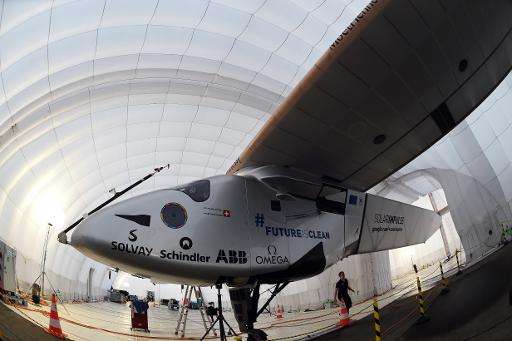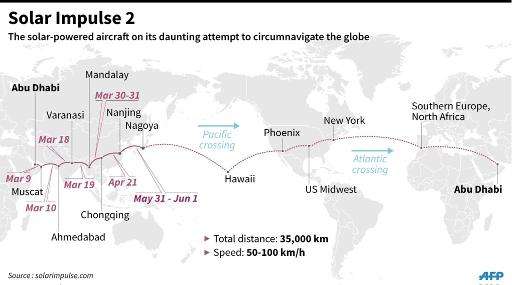Solar Impulse set to take off early Wednesday

A solar-powered plane that has been trapped in Japan for three weeks by the rainy season is set to take off for Hawaii early Wednesday, the team said.
Solar Impulse 2 had been trying to fly from Nanjing, China to Hawaii, when a developing weather front forced it to divert to the central Japanese city of Nagoya at the start of the month.
Ever since, the crew has been scouring long-range forecasts for an opportunity to restart the first ever round-the-world attempt by an aircraft powered only by the sun.
A chance to do so presented itself on Tuesday.
"Solar Impulse will attempt to fly to Hawaii on Wednesday, June 24th at 2:30am local time (1730 GMT, Tuesday)" the team said.
Mission co-founder Andre Borschberg, who flew for 44 hours to get to Nagoya, will climb back into the cockpit in the middle of Japan's night for a daring bid to reach Hawaii after five days and five nights of continuous flight.
Winds and turbulence tend to be calmer in the very early hours of the morning, Solar Impulse team spokeswoman Elke Neumann told AFP, making this time ideal for takeoffs.
"The batteries are full so the plane can fly anytime," she said. "Since the sun goes up very early in Japan, we are flying early... we fly much earlier, so we have much more time in the air."
Solar Impulse set off from Abu Dhabi earlier this year in a multi-leg attempt to get all the way around the world without a single drop of fuel.
The trip to Hawaii will be the eighth and most daunting leg of the circumnavigation.

The plane has 17,000 solar cells and on-board rechargeable batteries. Its top speed is 140 kilometres (90 miles) an hour.
Its wingspan is longer than a jumbo jet, but weighs only 2.3 tons—about the same as a car.
The plane is the successor to Solar Impulse, which managed a 26-hour flight in 2010, proving its ability to store enough power in lithium batteries during the day to keep flying at night.
Ridiculed by the aviation industry when it was first unveiled, the venture has since been hailed around the world, including by UN chief Ban Ki-moon.
© 2015 AFP





















